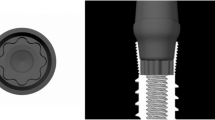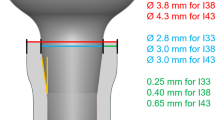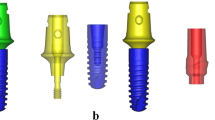Abstract
Microgap between implant and abutment can produce biological and mechanical problems such as peri-implantitis and/or fatigue failures. The aim of this study was to evaluate microgap size and fatigue behavior of external and internal connections. In both systems the torque to tighten the abutment screw of single crown abutments was 45 Ncm. Fifty implants for each connection type were studied. One subgroup (n = 5) was used by the observation and evaluation of the microgap, other (n = 5) was tested for fracture strength and the other (n = 40) was subjected to dynamic loading. The internal connection presents a lower microgap than the external ones. From fatigue results, the external hexagon interface showed superior result compared to the internal hexagon interfaces. The tolerances in the internal connections are better and favour the fatigue behavior but this factor alone is not sufficient to improve the fatigue response in relation to the external connections when the screw is subjected at the same torque. The external system presents a higher value of the area than the internal and it produces a better load distribution. Microgaps and mechanical properties are very important for the long-term behavior of the dental implants and these aspects should be known by the implantologists.







Similar content being viewed by others
References
Steinebrunner L, Wolfart S, Bobmann K, Kern M. In vitro evaluation of bacterial leakage along the implant–abutment interface of different implant systems. Int J Oral Maxillofac Implant. 2005;20:875–81.
Steinebrunner L, Wolfart S, Bobmann K, Kern M. Implant–abutment interface design affects fatigue and fracture strength of implants. Clin Oral Implant Res. 2008;19:1276–84.
Ritcher EJ. In vivo vertical forces on implants. Int J Oral Maxillofac Implant. 1995;10:99–108.
Waltimo A. Studies on human bite force: a novel bite force recorder and its clinical applications. Prosthetic dentistry. Helsinki: Med-Habilitation; 1995. p. 199–210.
Pjetursson BE, Tan Y, Lang NP, Bragger U, Egger M, Zwahlen M. A systematic review of the survival and complication rates of fixed partial dentures (fpds) after an observation period of at least 5 years. Clin Oral Implant Res. 2004;15:625–42.
Maeda Y, Satoh T, Sogo M. In vitro differences of stress concentrations for internal and external hex implant–abutment connections: a short communication. J. Oral Rehabil. 2006;33:75–8.
Khraisat A, Stegaroiu R, Nomura S, Miyakawa O. Fatigue resistance of two implant/abutment joint designs. J Prosthet Dent. 2002;88:604–10.
Khraisat A. Stability of implant–abutment interface with a hexagon mediated joint: failure mode and bending resistance. Clin Implant Dent Relat Res. 2005;7(4):221–8.
Quirynen M, van Steenberghe D. Bacterial colonization of the internal part of two stage implants: an in vivo study. Clin Oral Implant Res. 1993;4(3):158–61.
Piatelli A, Scarano A, Paolantonio M. Fluids and microbial penetration in the internal part of cement-retained versus screw-retained implant–abutment connections. J Periodontol. 2001;72:1146–50.
Huang HM, Tsai CM, Chang CC, Lin CT, Lee SY. Evaluation of loading conditions on fatigue-failed implants by fracture surface analysis. Int J Oral Maxillofac Implant. 2005;20(6):854–9.
Coelho AL, Suzuki M, Dibart S, Da Siva N, Coelho PG. Cross-sectional analysis of the implant–abutment interface. J Oral Rehabil. 2007;34(7):508–16.
Manero JM, Salsench J, Nogueras J, Aparicio C, Padrós A, Balcells M, Gil FJ, Planell JA. Growth of bioactive surfaces on dental implants. Implant Dent. 2002;11:170–5.
Gil FJ, Aparicio C, Manero JM, Padrós A. Influence of the height of the external hexagon and surface treatment on fatigue life of commercially pure titanium dental implants. Int J Oral Maxillofac Implant. 2009;24:583–90.
Rodríguez-Hernández A, Juárez A, Engel E, Gil FJ. Streptococcus sanguinis adhesion on titanium rough surfaces: effect of shot blasting particles. J Mater Sci Mater Med. 2010;22:1913–22.
Binon PP, Curtis DA. A classification system to measure the implant–abutment microgap. Int J Oral Maxillofac Implant. 2007;22(6):879–85.
Raoofi S, Khademi M, Amid R, Kadkhodazadeh M. Moyahhedi M.R. Comparison of the effect of three abutment–implant connections on stress distribution the internal surface on dental implants: a finite element analysis. J Dent Res Clin Dent Prospect. 2013;7(3):132–9.
Freitas-Junior AC, Almeida EO, Bonfante EA, Silva NRFA, Coelho PG. Reliability and failure modes of internal conical dental implant connections. Clin Oral Implant Res. 2012;1:1–6. doi:10.1111/j.1600-0501.2012.02443.x.
Acknowledgments
The authors are grateful to the CICYT MAT2012-30706 and Generalitat de Catalunya (CTP Project) and Andorra Government for funding the present work and to Klockner, S.L. for kindly donating the material. The authors do not present any interest conflict in this work
Author information
Authors and Affiliations
Corresponding author
Rights and permissions
About this article
Cite this article
Gil, F.J., Herrero-Climent, M., Lázaro, P. et al. Implant–abutment connections: influence of the design on the microgap and their fatigue and fracture behavior of dental implants. J Mater Sci: Mater Med 25, 1825–1830 (2014). https://doi.org/10.1007/s10856-014-5211-7
Received:
Accepted:
Published:
Issue Date:
DOI: https://doi.org/10.1007/s10856-014-5211-7




